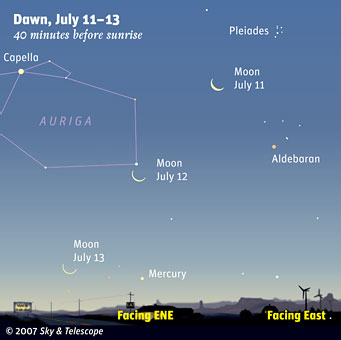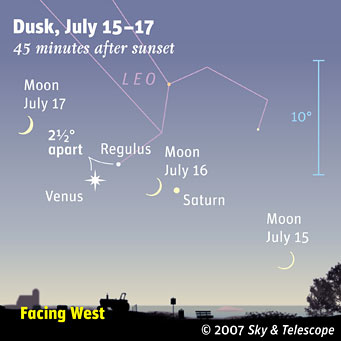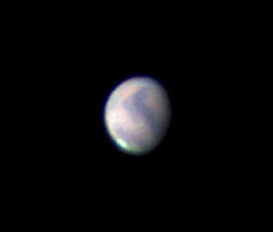Some daily events in the changing sky for July 6 – 14.

A preview of some "winter" stars awaits early risers in July. For a few mornings, the waning crescent Moon directs you to faint Mercury coming into view very low down. For Mercury, you'll need binoculars. (These scenes are drawn for the middle of North America. European observers: move each Moon symbol a quarter of the way toward the one for the previous date. For clarity, the Moon is shown three times actual size.)
Sky & Telescope diagram
Friday, July 6
Saturday, July 7
Sunday, July 8
Monday, July 9
Tuesday, July 10
Wednesday, July 11
Thursday, July 12
Friday, July 13
Saturday, July 14

Watch the Moon passing through the Venus-Saturn-Regulus activity on the 16th and 17th. The blue 10° scale is about the size of your fist held at arm's length.
Sky & Telescope diagram
Want to become a better amateur astronomer? Learn your way around the constellations. They're the key to locating everything fainter and deeper to hunt with binoculars or a telescope. For an easy-to-use constellation guide covering the whole evening sky, use the big monthly foldout map in each issue of Sky & Telescope, the essential magazine of astronomy. Or download our free Getting Started in Astronomy booklet (which only has bimonthly maps).
Once you get a telescope, to put it to good use you'll need a detailed, large-scale sky atlas (set of maps; the standard is Sky Atlas 2000.0) and good deep-sky guidebooks (such as Sky Atlas 2000.0 Companion or the enchanting though dated Burnham's Celestial Handbook). Read here how to use them most effectively.
More beginners' tips: "How to Start Right in Astronomy".
This Week's Planet Roundup
Mercury is dim and very low in the glow of sunrise, but getting higher and brighter daily.
Venus is at its greatest brilliancy this week (magnitude –4.7), but it's getting low in the west during twilight. Saturn, much dimmer, continues moving farther off to its right. Meanwhile Regulus closes in on Venus from the upper left — and crosses above it late in the week.

Despite Mars's still-tiny apparent size, Larry Owens of Alpharetta, Georgia, recorded the developing Martian dust storm (bright area from left edge to lower right) on the morning of June 27th. The dark feature protruding toward the top is Syrtis Major. Owens used a 14-inch Celestron Schmidt-Cassegrain telescope and an Imaging Source DMK 21AF04 webcam. North is up.
Larry Owens
Mars (magnitude +0.6, in Aries) is gradually getting higher in the east before dawn. In a telescope it's still only 6 or 7 arcseconds wide. Nevertheless, amateurs who can do top-quality planetary imaging have been tracking the dust storm that is now reducing solar power to the Mars Exploration Rovers on the surface. The drop in available power has delayed the descent of Opportunity into Victoria Crater.
Jupiter (magnitude –2.5, in southern Ophiuchus) is a month past opposition. It glares in the southeast to south during evening — you can't miss it. Antares, less bright, sparkles redly 5° to Jupiter's lower right. The two remain evening companions all summer.
Saturn (magnitude +0.6, in Leo) continues to move farther to the right of Venus in twilight, as both sink lower toward the horizon day by day.
Uranus (magnitude 5.8, in Aquarius) and Neptune (magnitude 7.8, in Capricornus) are well up in the southeast and south during early morning hours.
Pluto (magnitude 13.9, in the northwestern corner of Sagittarius) is not far from Jupiter. Finder charts for Uranus, Neptune, and Pluto are in the July Sky & Telescope, page 60.
All descriptions that relate to your horizon — including the words up, down, right, and left — are written for the world's midnorthern latitudes. Descriptions that also depend on longitude (mainly Moon positions) are for North America. Eastern Daylight Time (EDT) equals Universal Time (UT, UTC, or GMT) minus 4 hours.
To always get the up-to-date Sky at a Glance, bookmark this URL:
http://SkyTonight.com/observing/ataglance .
 0
0
Comments
You must be logged in to post a comment.